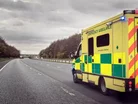Apple will automatically share emergency locations with 911 dispatchers

The 911 emergency service has not been updated since its implementation in the 1930s in the United Kingdom (999 service) and the United States since the 1990s.
However, Apple is set to disrupt the traditional emergency lines through its Apple iOS 12 technology.
More individuals now use mobile technology than traditional, outdated landline phones to contact emergency services. To reflect this change, Apple has announced that through its software upgrade, users will automatically be able to share their location when they dial 911, in a bid to reduce emergency response times and accurately provide their location, anywhere across the US.
The company’s HELO (Hybridised Emergency Location) previously estimated a mobile 911 caller’s location using cell towers and on-device data sources, such as GPS and Wi-Fi Access Points. Now, the company will utilise RapidSOS’s Internet Protocol-based data pipeline to quickly and securely share HELO location data with 911 centres.
RapidSOS’s system will deliver the emergency location data of iOS users by integrating with many 911 centres’ existing software.
“Communities rely on 911 centres in an emergency, and we believe they should have the best available technology at their disposal,” said Tim Cook, Apple’s CEO. “When every moment counts, these tools will help first responders reach our customers when they most need assistance.”
Only the responding 911 centre will have access to the user’s location during an emergency call.
See also
- Looking past the hype: Getting real-world results from AI in healthcare
- Dive-by medicine
- Meet the doctors of data
“911 telecommunicators do extraordinary work managing millions of emergencies with little more than a voice connection,” added RapidSOS CEO, Michael Martin.
“We are excited to work with Apple to provide first responders a new path for accurate, device-based caller location using transformative Next Generation 911 technology.”
The FCC requires carriers to locate callers to within 50 meters at least 80 percent of the time by 2021. iOS location services are capable of exceeding this requirement today.
“We’re thrilled that Apple is giving 911 centres access to device-based location data via a thoroughly-tested, standards-based approach,” commented Rob McMullen, President of the National Emergency Number Association, the 911 Association.
“This will accelerate the deployment of Next Generation 911 for everyone, saving lives and protecting property.”
“This new functionality is an example of how companies and first responders can use technology to dramatically improve public safety,” added Tom Wheeler, FCC Chairman from 2013 to 2017.
“Lives will be saved thanks to this effort by Apple and RapidSOS.”
“Helping 911 services quickly and accurately assess caller location has been a major issue since my time at the FCC,” noted Dennis Patrick, FCC Chairman from 1987 to 1989. “This advancement from Apple and RapidSOS will be transformative for emergency
- How Zipline Uses Drones to Deliver Medicine Across AfricaTechnology & AI
- How is Schneider Electric Making the NHS More Accessible?Hospitals
- How DeepHealth is Using AI to Screen for Breast CancerTechnology & AI
- Martin Carpenter: How Tech is Reshaping Healthcare on JerseyDigital Healthcare



